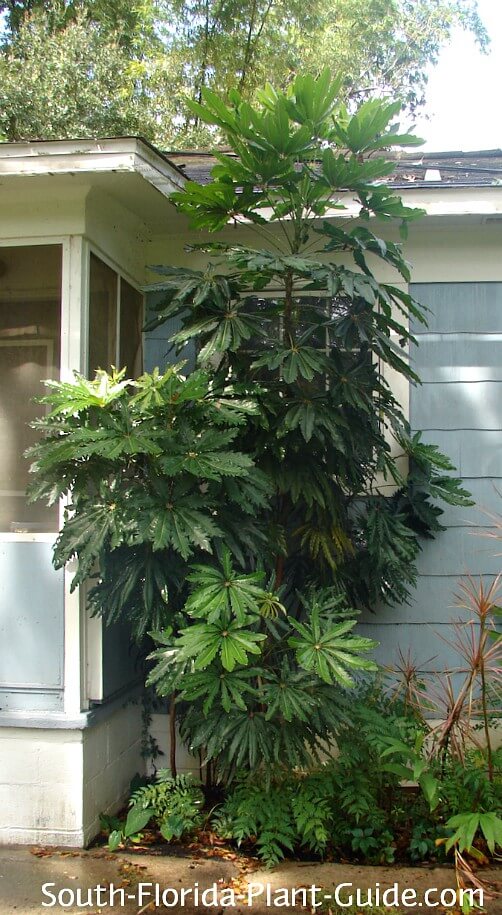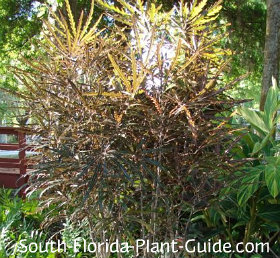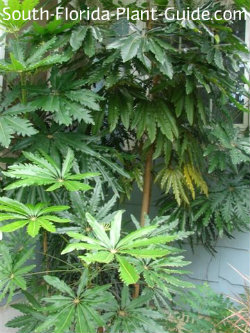False Aralia
Schefflera elegantissima
(formerly Dizygotheca elegantissima)
The exotic false aralia, with its lacy leaves and tropical beauty, is perfect for narrow, shady spots.

Elegant as its botanical name implies, this plant goes through a transformation for a completely different look as it matures.
The young leaves are very narrow and dark - almost bronze - with serrated edges.
As the plant matures, it morphs into feathery layers of wider green leaves with softer jagged edges.
Both leaf sizes and colors appear
on the plant at the same time, giving it a lush texture.
False aralia grows tall and upright and works very well in tight spaces.
Use it as an architectural accent in front of columns or tucked into a recessed area.
It can also provide semi-privacy in front of a window,
and is a lovely alternative to other somewhat narrow plants like
podocarpus.
These tall shrubs are underused because not enough homeowners are familiar with them. Like a number of South Florida landscape plants, this is used as a pretty houseplant in less warm climates.

(Leaves of a young plant on the left, mature ones on the right)

The plant bears a striking resemblance to marijuana, and may get your neighbors talking.
In an episode of the 70's sitcom Three's Company, Jack and Chrissy find this pot look-alike in the Roper's garden but Janet later saves the day by identifying it as false aralia.
Plant specs
False aralia is evergreen, and a moderate grower you can keep 5 to 8 feet...or let it grow larger (15 feet or more) if you prefer.
This plant prefers part shade, with a bit of morning sun, or dappled shade is ideal, though the plant will grow in full shade or even part sun.
Tropical plants like this one need the warmth of Zone 10.
In Zone 9B you can use it as a container plant, bringing it indoors during cold weather.
Plant care
Add a combination of top soil (or organic peat humus) and cow manure to the hole when you plant.
You can grow this plant as a shrub or a multi-trunk tree. Larger stems will generally be a bit bare at the bottom anyway, so to make it more tree-like keep smaller shoots that normally fill in the blanks trimmed back to expose the "trunks."
No trimming is needed to grow as a tall shrub, and the plant has an attractive way of being full and lush and yet somewhat open at the same time.
To keep it shorter and bushier give it a regular "haircut." You can cut back too-tall stalks shorter in spring (late March or early April), leaving the smaller ones to fill in. New growth will emerge from around the top of the cut stalk.
Water on a regular basis but don't keep it overly wet. The planting area should be well-drained.
Fertilize in spring, summer, and autumn with a good quality granular fertilizer. You can also supplement feedings with liquid fertilizer.
Plant spacing
Plant 3 feet apart. Come out from the house 2-1/2 to 3 feet.
If planting by a walk or drive, leave 4 feet of clearance.
This is an excellent container plant and will grow indoors if given some humidity.
Landscape uses for false aralia
- tall accent for a mixed bed
- single yard specimen
- backdrop for smaller plants
- semi-privacy plant
- architectural accent
- on each side of a garden gate
- for height and interest on a blank wall
- container plant for porch, deck, patio or poolcage
GOOD SNOWBIRD PLANT? YES
COMPANION PLANT SUGGESTIONS: Butterfly ginger, fishtail fern, cordyline, elephant ears, variegated peperomia, tibouchina, caladium, and amaryllis.
Other plants you might like: False Ashoka Tree, Schefflera
Take a break!
The ultimate guide to low-maintenance plants
and landscaping!
An ebook by
Chase Landre
author of
South-Florida-Plant-Guide.com
Learn more!
Get a greener thumb!
Want to learn more about South Florida planting, watering, fertilizing and dealing with weeds and pests?
See our Gardening How-To section for answers!


